A New Typhoon-Monitoring Method Using Precipitation Water Vapor
Abstract
:1. Introduction
2. Study Area and Data Description
2.1. Study Area
2.2. Data Description
3. Anomalous Analysis of PWV with other Atmospheric Parameters during the Typhoon Period
3.1. Validation of ERA5-Derived PWV Using GNSS and Radiosonde Data
3.2. Validation of ERA5-Derived PWV Using GNSS and Radiosonde Data
3.2.1. Relationship between PWV and Precipitation
3.2.2. Relationship between PWV and Pressure
3.2.3. Relationship between PWV and Wind
3.3. PWV Variation during the Typhoon Hato
4. A New Method for Typhoon Monitoring Based on PWV
4.1. Theory Description of Typhoon Monitoring
4.1.1. Theory of Determining Typhoon Velocity Based on PWV
4.1.2. Theory of Typhoon Monitoring That Includes Acceleration
4.2. Experiment Validation
4.2.1. Experimental Analysis of Typhoon Velocity Monitoring using PWV
4.2.2. Simulated Experimental Analysis of Typhoon Monitoring Considering the Acceleration
5. Conclusions
Author Contributions
Funding
Acknowledgments
Conflicts of Interest
References
- Munich, R. Topics 2000: Natural Catastrophes-the Current Position; Munich RE: Munich, Germany, 1999. [Google Scholar]
- Wang, R.; Jiang, T.; Lorenz, K.; Marco, G.; Anja, H. Review on global natural catastrophes in the 20th century. J. Nat. Disasters 2000, 9, 9–15. [Google Scholar]
- Bender, M.A.; Knutson, T.R.; Tuleya, R.E.; Sirutis, J.J.; Vecchi, G.A.; Garner, S.T.; Held, I.M. Modeled impact of anthropogenic warming on the frequency of intense Atlantic hurricanes. Science 2010, 327, 454–458. [Google Scholar] [CrossRef] [PubMed]
- Liu, D.; Pang, L.; Xie, B. Typhoon disaster in China: Prediction, prevention, and mitigation. Nat. Hazards 2009, 49, 421–436. [Google Scholar] [CrossRef]
- Field, C.B. (Ed.) Climate Change 2014–Impacts, Adaptation and Vulnerability: Regional Aspects; Cambridge University Press: Cambridge, UK, 2014. [Google Scholar]
- Zhao, Q.; Yao, Y.; Yao, W. GPS-based PWV for precipitation forecasting and its application to a typhoon event. J. Atmos. Sol. Terr. Phys. 2018, 167, 124–133. [Google Scholar] [CrossRef]
- Lu, J.; Feng, T.; Li, J.; Cai, Z.; Xu, X.; Li, L.; Li, J. Impact of assimilating himawari-8-derived layered precipitable water with varying cumulus and microphysics parameterization schemes on the simulation of typhoon hato. J. Geophys. Res. Atmos. 2019, 124, 3050–3071. [Google Scholar] [CrossRef]
- Fontaine, B.; Roucou, P.; Trzaska, S. Atmospheric water cycle and moisture fluxes in the West African monsoon: Mean annual cycles and relationship using NCEP/NCAR reanalysis. Geophys. Res. Lett. 2003, 30, 1117. [Google Scholar] [CrossRef]
- Gilford, D.; Randel, W.J. Analyzing nearly four decades of historical radiosonde observations of tropical tropopause layer and cold-point temperatures. In AGU Fall Meeting Abstracts; American Geophysical Union: Washington, DC, USA, 2017. [Google Scholar]
- Schmid, B.; Hegg, D.A.; Wang, J.; Bates, D.; Redemann, J.; Russell, P.B.; Flagan, R.C. Column closure studies of lower tropospheric aerosol and water vapor during ACE-Asia using airborne Sun photometer and airborne in situ and ship-based lidar measurements. J. Geophys. Res. Atmos. 2003, 108, ACE 24-1–ACE 24-22. [Google Scholar] [CrossRef]
- Boone, C.D.; Walker, K.A.; Bernath, P.F. Speed-dependent voigt profile for water vapor in infrared remote sensing applications. J. Quant. Spectrosc. Radiat. Transf. 2007, 105, 525–532. [Google Scholar] [CrossRef]
- Pérez-Ramírez, D.; Navas-Guzmán, F.; Lyamani, H.; Fernández-Gálvez, J.; Olmo, F.J.; Alados-Arboledas, L. Retrievals of precipitable water vapor using star photometry: Assessment with Raman lidar and link to sun photometry. J. Geophys. Res. Atmos. 2012, 117. [Google Scholar] [CrossRef]
- Chen, B.; Liu, Z. Analysis of precipitable water vapor (PWV) data derived from multiple techniques: GPS, WVR, radiosonde and NHM in Hong Kong. In China Satellite Navigation Conference (CSNC) 2014 Proceedings: Volume I; Springer: Berlin/Heidelberg, Germany, 2014; pp. 159–175. [Google Scholar]
- Bevis, M.; Businger, S.; Herring, T.A.; Rocken, C.; Anthes, R.A.; Ware, R.H. GPS meteorology: Remote sensing of atmospheric water vapor using the Global Positioning System. J. Geophys. Res. Atmos. 1992, 97, 15787–15801. [Google Scholar] [CrossRef]
- Lee, S.W.; Kouba, J.; Schutz, B.; Kim, D.H.; Lee, Y.J. Monitoring precipitable water vapor in real-time using global navigation satellite systems. J. Geod. 2013, 87, 923–934. [Google Scholar] [CrossRef]
- Shoji, Y.; Sato, K.; Yabuki, M.; Tsuda, T. Comparison of shipborne GNSS-derived precipitable water vapor with radiosonde in the western North Pacific and in the seas adjacent to Japan. Earth Planets Space 2017, 69, 153. [Google Scholar] [CrossRef]
- Zhang, W.; Lou, Y.; Huang, J.; Zheng, F.; Cao, Y.; Liang, H.; Liu, J. Multiscale variations of precipitable water over China based on 1999–2015 ground-based GPS observations and evaluations of reanalysis products. J. Clim. 2018, 31, 945–962. [Google Scholar] [CrossRef]
- Yao, Y.; Shan, L.; Zhao, Q. Establishing a method of short-term rainfall forecasting based on GNSS-derived PWV and its application. Sci. Rep. 2017, 7, 12465. [Google Scholar] [CrossRef] [PubMed]
- Choy, S.; Wang, C.; Zhang, K.; Kuleshov, Y. GPS sensing of precipitable water vapour during the March 2010 Melbourne storm. Adv. Space Res. 2013, 52, 1688–1699. [Google Scholar] [CrossRef]
- Tang, X.; Hancock, C.; Xiang, Z.; Kong, Y.; Ligt, H.; Shi, H.; Quaye-Ballard, J. Precipitable water vapour retrieval from GPS precise point positioning and NCEP CFSv2 dataset during typhoon events. Sensors 2018, 18, 3831. [Google Scholar] [CrossRef]
- Nykiel, G.; Figurski, M.; Baldysz, Z. Analysis of GNSS sensed precipitable water vapour and tropospheric gradients during the derecho event in Poland of 11th August 2017. J. Atmos. Sol. Terr. Phys. 2019, 193, 105082. [Google Scholar] [CrossRef]
- Olauson, J. ERA5: The new champion of wind power modelling? Renew. Energy 2018, 126, 322–331. [Google Scholar] [CrossRef]
- Zhang, W.; Lou, Y.; Haase, J.S.; Zhang, R.; Zheng, G.; Huang, J.; Liu, J. The use of ground-based GPS precipitable water measurements over China to assess radiosonde and ERA-Interim moisture trends and errors from 1999 to 2015. J. Clim. 2017, 30, 7643–7667. [Google Scholar] [CrossRef]
- Xiao, Y.F.; Duan, Z.D.; Xiao, Y.Q.; Ou, J.P.; Chang, L.; Li, Q.S. Typhoon wind hazard analysis for southeast China coastal regions. Struct. Saf. 2011, 33, 286–295. [Google Scholar] [CrossRef]
- Wei, L.; Li, J.; Yang, X. ExpErimEnts on impact-basEd ForEcasting and risk-basEd Warning of typhoon in China. Trop. Cyclone Res. Rev. 2018, 7, 31–36. [Google Scholar]
- Ying, M.; Zhang, W.; Yu, H.; Lu, X.; Feng, J.; Fan, Y.; Chen, D. An overview of the China meteorological administration tropical cyclone database. J. Atmos. Ocean. Technol. 2014, 31, 287–301. [Google Scholar] [CrossRef]
- Dee, D.P.; Uppala, S.M.; Simmons, A.J.; Berrisford, P.; Poli, P.; Kobayashi, S.; Bechtold, P. The ERA-Interim reanalysis: Configuration and performance of the data assimilation system. Q. J. R. Meteorol. Soc. 2011, 137, 553–597. [Google Scholar] [CrossRef]
- Zhao, Q.; Yao, Y.; Yao, W.; Zhang, S. GNSS-derived PWV and comparison with radiosonde and ECMWF ERA-Interim data over mainland China. J. Atmos. Sol. Terr. Phys. 2019, 182, 85–92. [Google Scholar] [CrossRef]
- Yuan, Y.; Zhang, K.; Rohm, W.; Choy, S.; Norman, R.; Wang, C.S. Real-time retrieval of precipitable water vapor from GPS precise point positioning. J. Geophys. Res. Atmos. 2014, 119, 10044–10057. [Google Scholar] [CrossRef]
- Rybin, E.N.; Valyukhov, V.P.; Kuptsov, V.D. Thermodynamics of supersaturated vapor nucleation on molecular condensation nuclei. Tech. Phys. 2012, 57, 1062–1067. [Google Scholar] [CrossRef]
- Jiao, J.; Su, D.; Wang, Y. Dynamics of water vapor content around isolated sprinklers: Description and validation of model. Water 2017, 9, 307. [Google Scholar] [CrossRef]
- Campbell, S.L.; Kunkel, P.; Bobinyec, K. A minimal norm corrected underdetermined Gauß—Newton procedure. Appl. Numer. Math. 2012, 62, 592–605. [Google Scholar] [CrossRef]
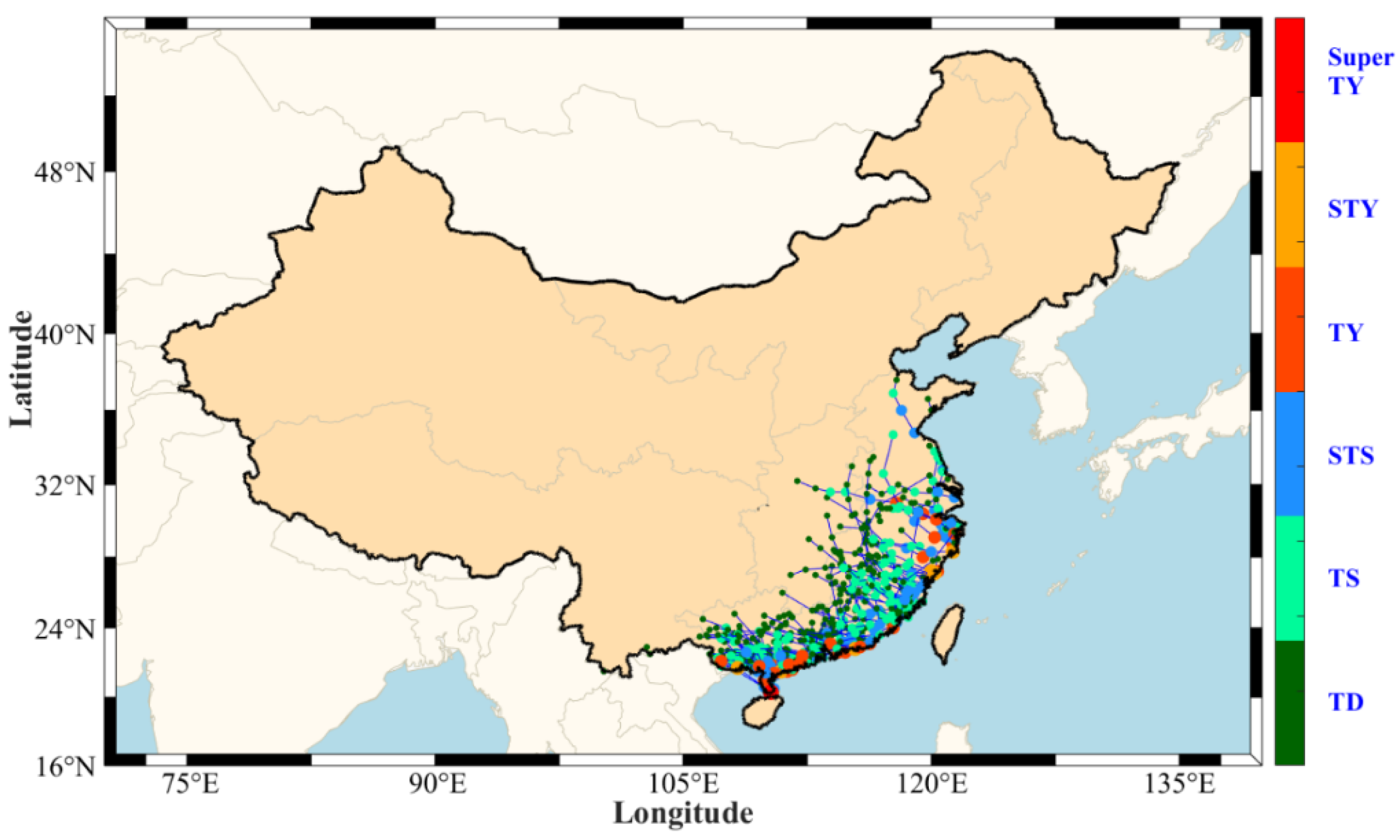


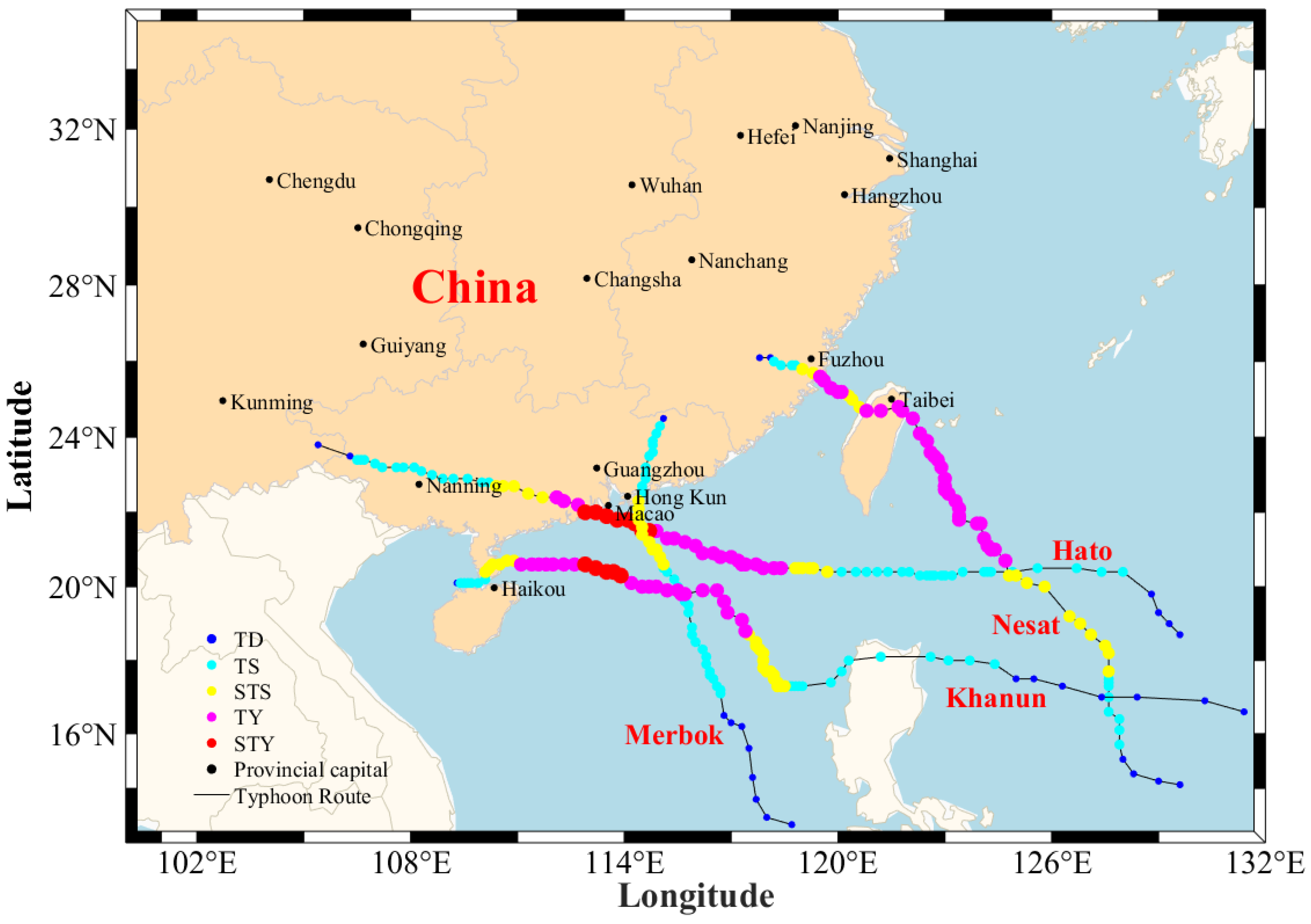
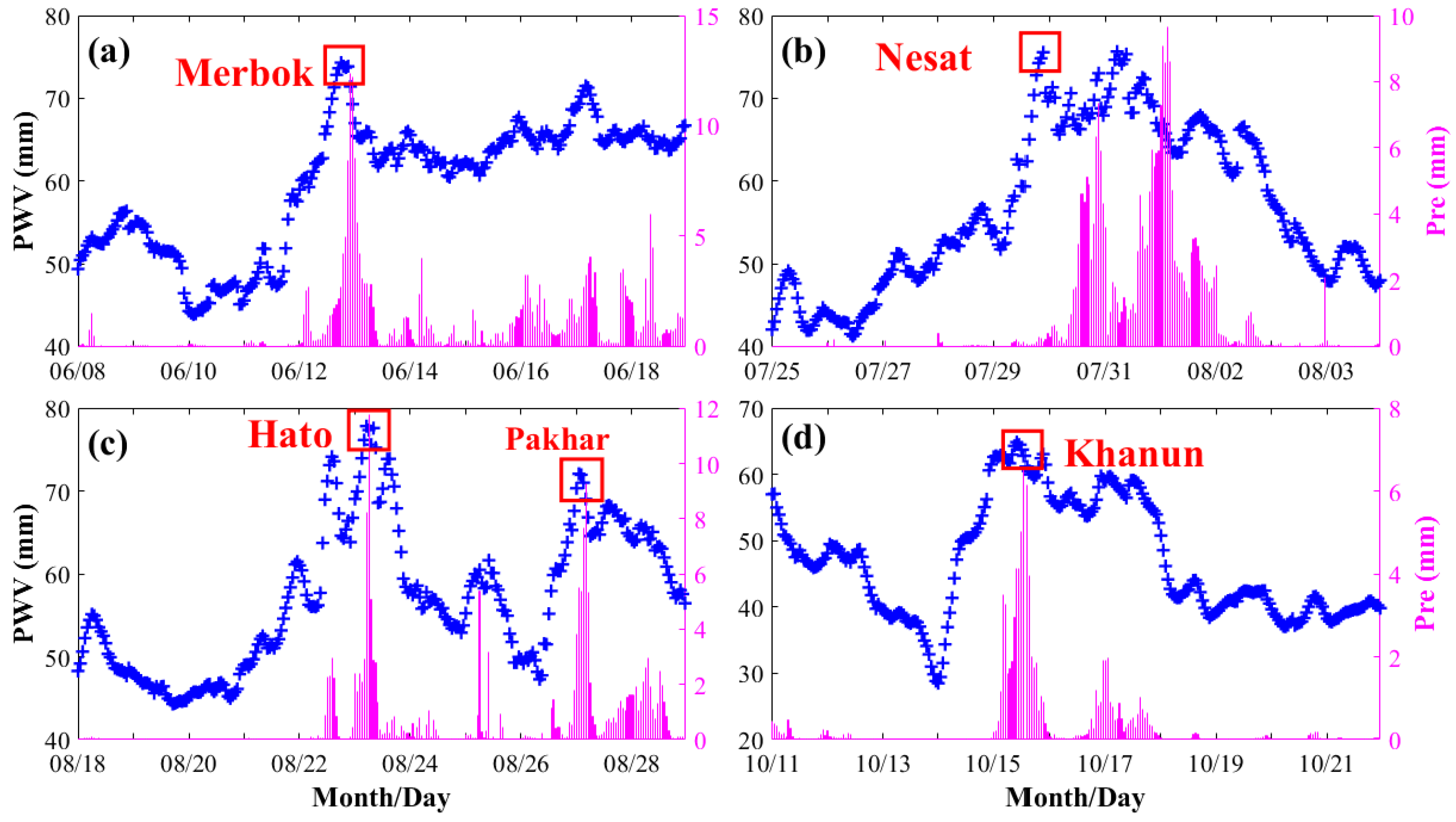
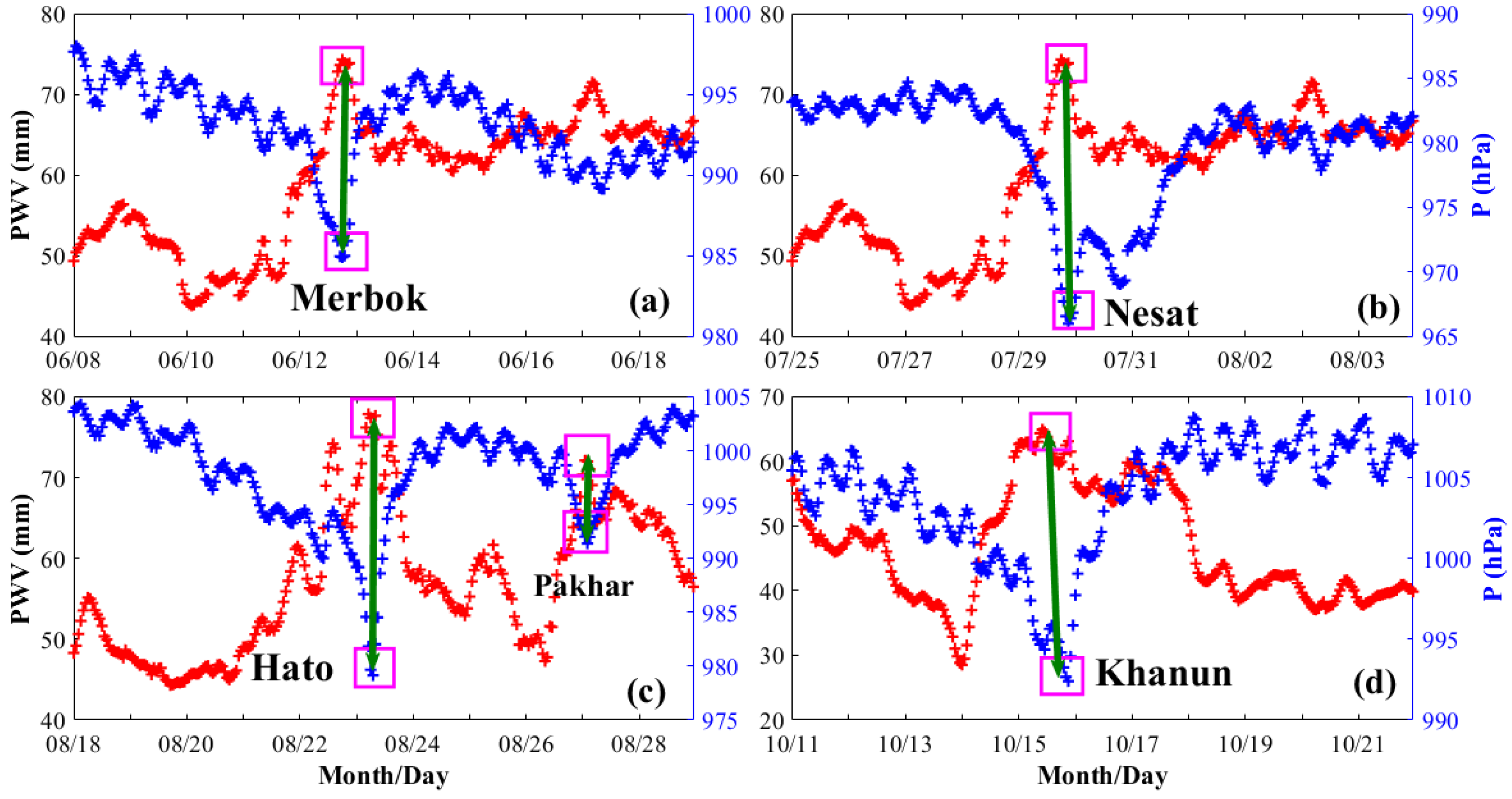
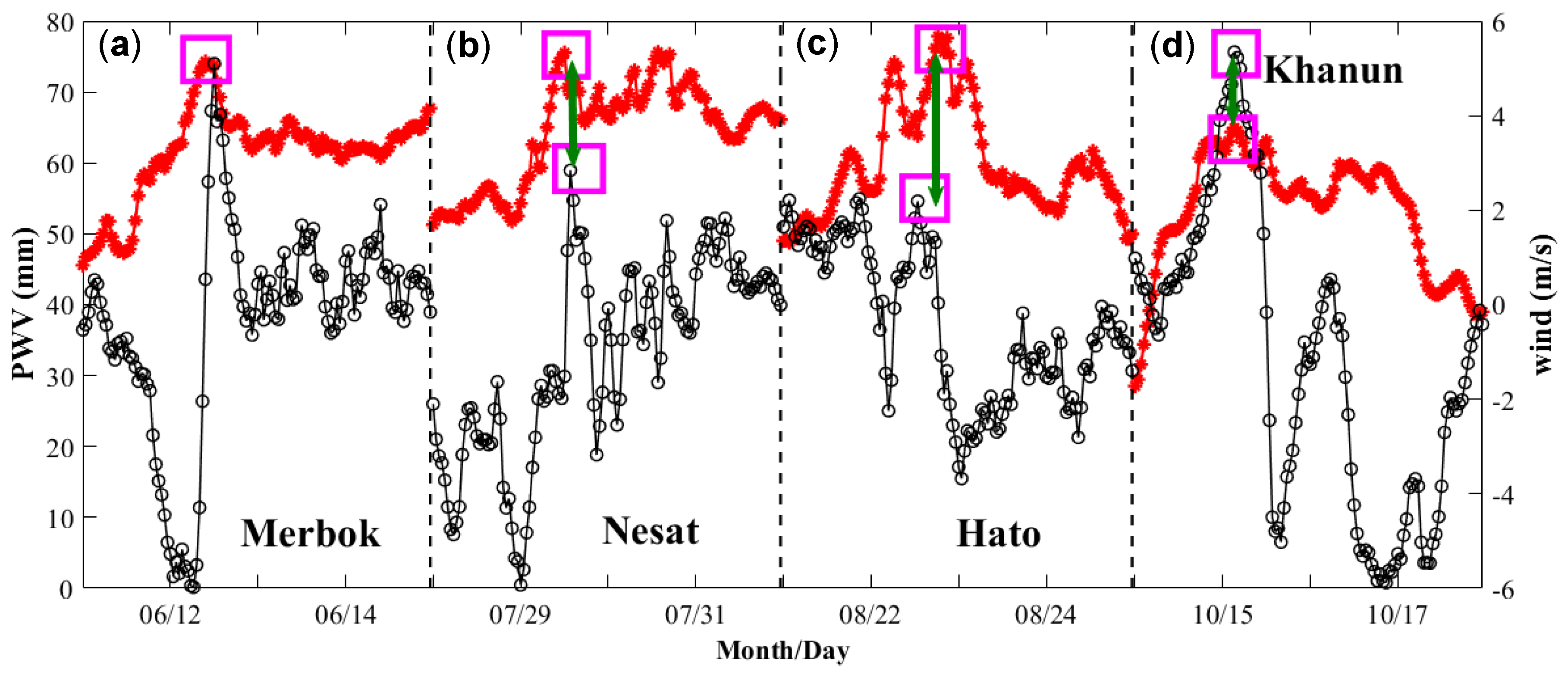
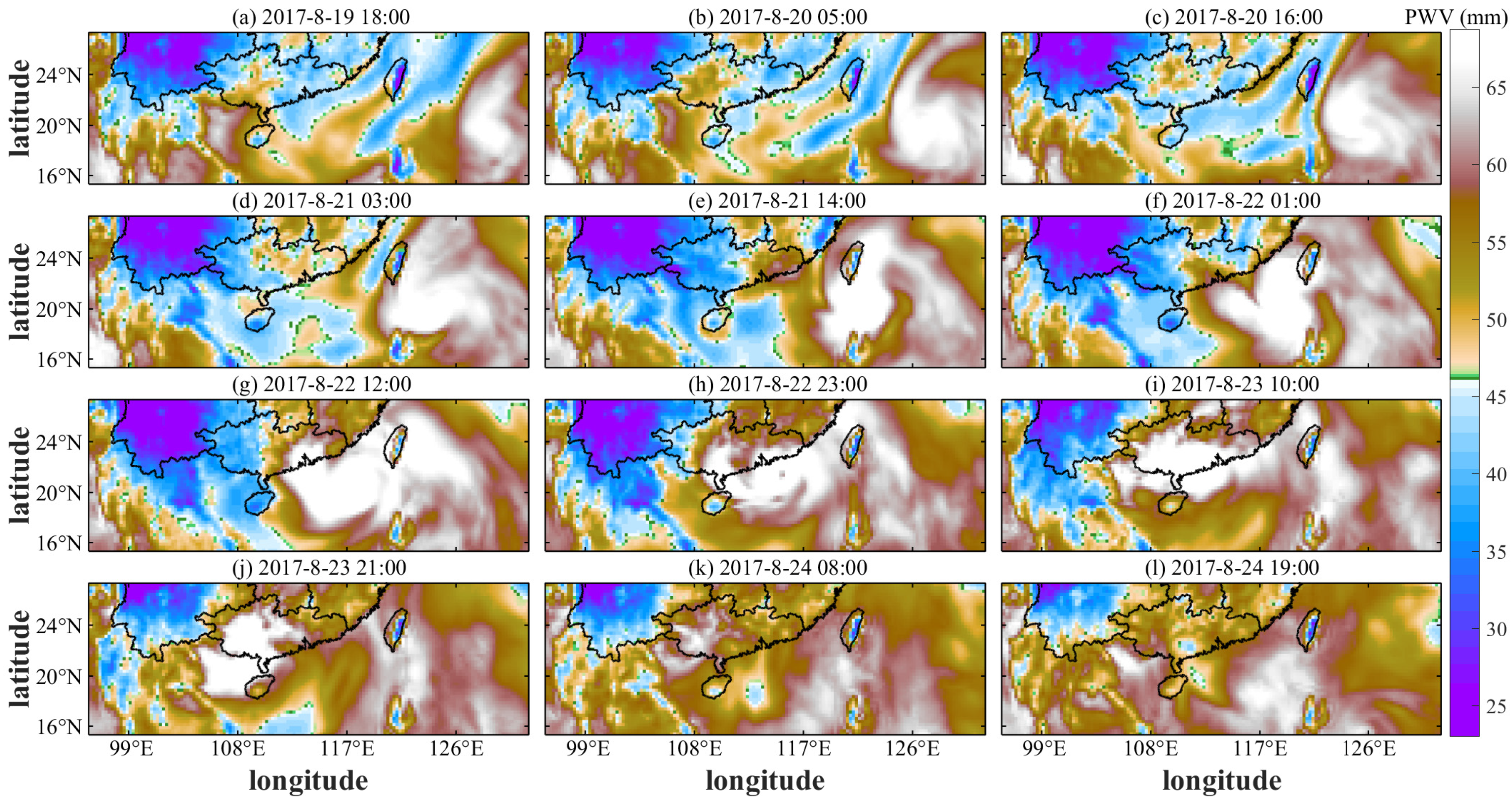
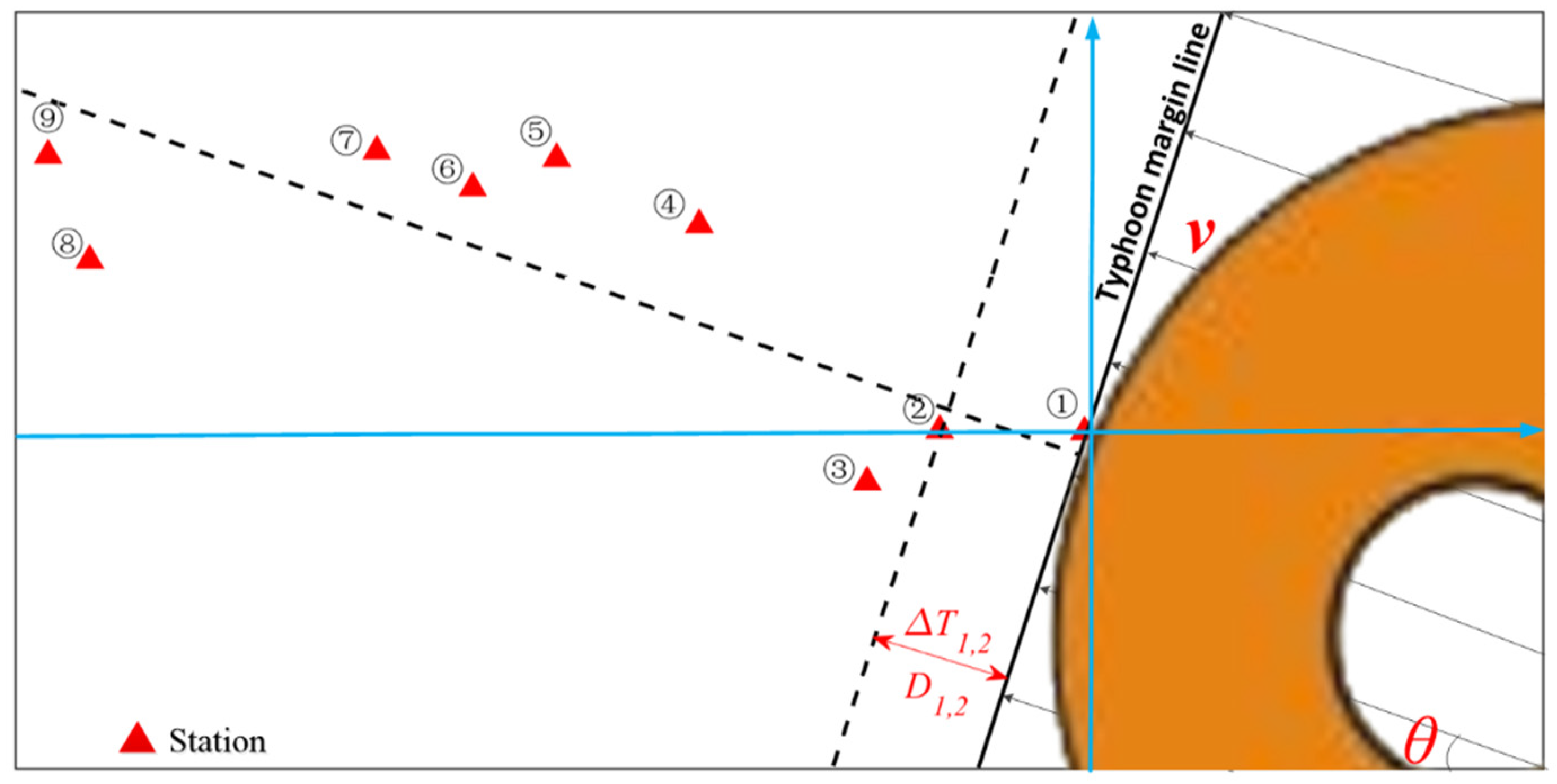
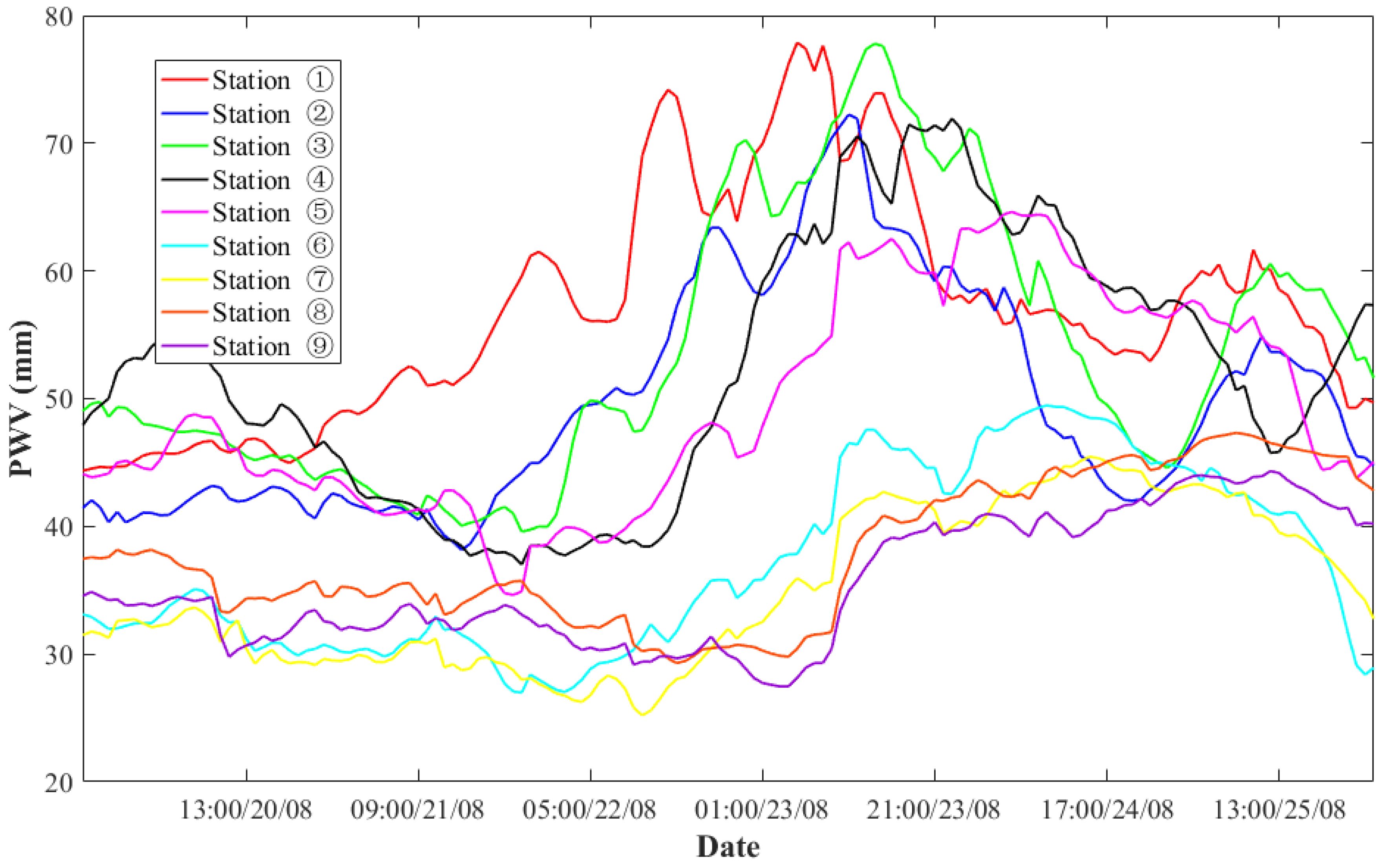
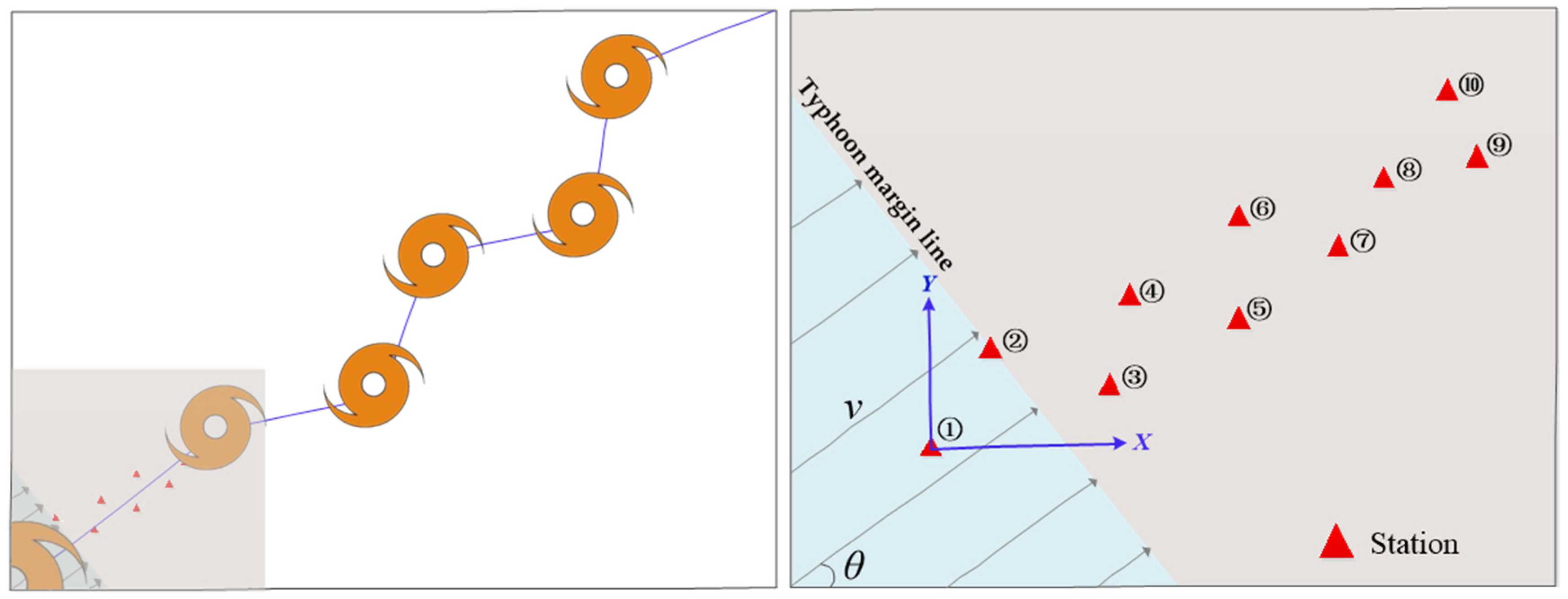

| Intensity | Description |
|---|---|
| TD | Tropical depression (10.8–17.1 m/s, Beaufort wind magnitude 6–7) |
| TS | Tropical storm (17.2–24.4 m/s, Beaufort force 8–9) |
| STS | Severe tropical storm (24.5–32.6 m/s, Beaufort force 10–11) |
| TY | Typhoon (32.7–41.4 m/s, Beaufort force 12–13) |
| STY | Strong typhoon (41.5–50.9 m/s, Beaufort category 14–15) |
| SuperTY | Super typhoon (greater than or equal to 51.0 m/s, Beaufort wind level ≥16) |
| Year | Month | Day | Hour | Δti | Typhoon v (km/h) | Mean v (km/h) | Estimated v (km/h) |
|---|---|---|---|---|---|---|---|
| 2017 | 8 | 23 | 5 | 0 | 30 | ||
| 2017 | 8 | 23 | 6 | 27 | 29.57 | 31.36 | |
| 7 | 30 | ||||||
| 8 | 30 | ||||||
| 9 | 30 | ||||||
| 10 | 30 | ||||||
| 11 | 6 | 30 | |||||
| 2017 | 8 | 23 | 12 | 26 | 27.75 | 30 | |
| 13 | 25 | ||||||
| 14 | 9 | 30 | |||||
| 2017 | 8 | 23 | 15 | 30 | 26.4 | 26.39 | |
| 16 | 30 | ||||||
| 17 | 25 | ||||||
| 18 | 25 | ||||||
| 19 | 20 | ||||||
| 20 | 28 | ||||||
| 21 | 25 | ||||||
| 22 | 23 | ||||||
| 23 | 18 | 28 | |||||
| 2017 | 8 | 24 | 0 | 26 | 26 | 27.16 | |
| 1 | 23 | ||||||
| 2 | 25 | ||||||
| 3 | 25 | ||||||
| 4 | 25 | ||||||
| 5 | 29 | ||||||
| 6 | 25 | 27 | |||||
| 2017 | 8 | 24 | 7 | 27 | 27 | 26.68 | |
| 8 | 27 | ||||||
| 9 | 27 | ||||||
| 10 | 29 | 27 | |||||
| 2017 | 8 | 24 | 11 | 27 | 26.4 | 25.48 | |
| 12 | 27 | ||||||
| 13 | 27 | ||||||
| 14 | 24 | ||||||
| 15 | 34 | * | |||||
| 2017 | 8 | 25 | 8 | 51 | * | * | 21.44 |
| 2017 | 8 | 25 | 12 | 55 | * | * | 15.49 |
| Number of Stations | Typhoon Location | Parameter Remained Estimated | Real Values | Estimated Values |
|---|---|---|---|---|
| 12 | x: 20 y: 15 | θ (°) | 36.87 | 36.87 |
| a (km/h2) | 10.00 | 9.60 | ||
| v (km/h) | 20.00 | 19.63 | ||
| 8 | x: 22.5 y: 13 | θ (°) | 30.02 | 30.02 |
| a (km/h2) | 3.97 | 3.97 | ||
| v (km/h) | 24.00 | 24.00 | ||
| 8 | x: 18 y: 26 | θ (°) | 55.30 | 55.30 |
| a (km/h2) | 16.25 | 16.25 | ||
| v (km/h) | 23.50 | 23.50 | ||
| 10 | x: 22 y: 22 | θ (°) | 45.00 | 45.00 |
| a (km/h2) | 2.23 | 2.23 | ||
| v (km/h) | 30.00 | 30.00 | ||
| 7 | x: 20 y: 15 | θ (°) | 40.73 | 40.73 |
| a (km/h2) | 5.51 | 5.51 | ||
| v (km/h) | 21.00 | 21.00 |
© 2019 by the authors. Licensee MDPI, Basel, Switzerland. This article is an open access article distributed under the terms and conditions of the Creative Commons Attribution (CC BY) license (http://creativecommons.org/licenses/by/4.0/).
Share and Cite
Zhao, Q.; Ma, X.; Yao, W.; Yao, Y. A New Typhoon-Monitoring Method Using Precipitation Water Vapor. Remote Sens. 2019, 11, 2845. https://doi.org/10.3390/rs11232845
Zhao Q, Ma X, Yao W, Yao Y. A New Typhoon-Monitoring Method Using Precipitation Water Vapor. Remote Sensing. 2019; 11(23):2845. https://doi.org/10.3390/rs11232845
Chicago/Turabian StyleZhao, Qingzhi, Xiongwei Ma, Wanqiang Yao, and Yibin Yao. 2019. "A New Typhoon-Monitoring Method Using Precipitation Water Vapor" Remote Sensing 11, no. 23: 2845. https://doi.org/10.3390/rs11232845
APA StyleZhao, Q., Ma, X., Yao, W., & Yao, Y. (2019). A New Typhoon-Monitoring Method Using Precipitation Water Vapor. Remote Sensing, 11(23), 2845. https://doi.org/10.3390/rs11232845






